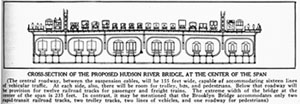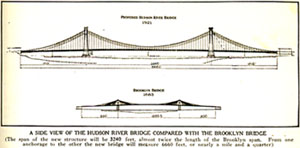An Unbuilt Bridge
Today, an unbuilt bridge. The University of Houston's College of Engineering presents this series about the machines that make our civilization run, and the people whose ingenuity created them.
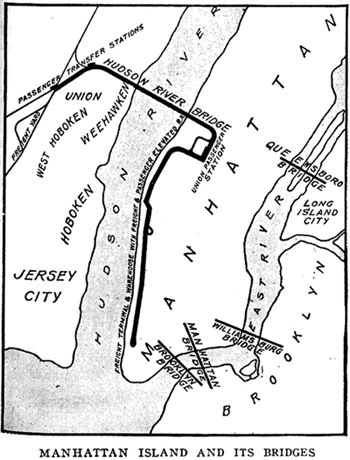 Manhattan Island is isolated by three rivers. On the west, the Hudson is about three-quarters of a mile wide. The East River narrows to just over a quarter of a mile, across from Brooklyn and Long Island. In the north, the Harlem River separates Manhattan from the New York mainland by a scant four-hundred-and-some feet. Naturally, the Harlem River was first to be bridged. Thirteen bridges now cross it (if you count two that connect through Randalls Island.)
Manhattan Island is isolated by three rivers. On the west, the Hudson is about three-quarters of a mile wide. The East River narrows to just over a quarter of a mile, across from Brooklyn and Long Island. In the north, the Harlem River separates Manhattan from the New York mainland by a scant four-hundred-and-some feet. Naturally, the Harlem River was first to be bridged. Thirteen bridges now cross it (if you count two that connect through Randalls Island.)
When the Brooklyn Bridge opened in 1883, Manhattan was finally connected with Long Island, across the East River. But a half century later, the sprawling Hudson was yet to be bridged. The new motor vehicles could not yet drive west into New Jersey.
So I blink when open the 1921 American Review of Reviews and find a dramatic drawing of a 3240-foot central span, seeming to stretch off into infinity. The title below it cries, The World's Greatest Bridge. This heroic roadway was meant to link central Manhattan to the west at last. Its central span would be more than twice that of the Brooklyn Bridge -- still the world's largest. The article stresses the gnawing need for such a link. (By the way, construction of what would later be called the Holland Tunnel had just begun and it's not mentioned here.)
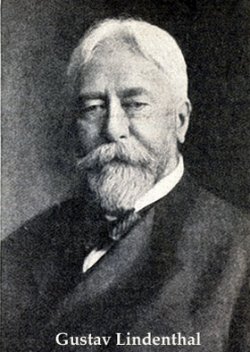 The engineer, seventy-one-year-old Gustav Lindenthal, was no slouch at bridge design. It was he who'd already designed the lovely Hell Gate Bridge into Queens. Linking Manhattan to the rest of America was Lindenthal's life-long objective. He'd first proposed a bridge to New Jersey way back in 1888. That early design, like his Hell Gate bridge, would've been a long steel truss. Now he proposes to build the world's longest suspension bridge. And he offers theatre beyond mere length.
The engineer, seventy-one-year-old Gustav Lindenthal, was no slouch at bridge design. It was he who'd already designed the lovely Hell Gate Bridge into Queens. Linking Manhattan to the rest of America was Lindenthal's life-long objective. He'd first proposed a bridge to New Jersey way back in 1888. That early design, like his Hell Gate bridge, would've been a long steel truss. Now he proposes to build the world's longest suspension bridge. And he offers theatre beyond mere length.
Any bridge over the Hudson will have to clear heavy ship traffic. Lindenthal's bridge would soar 155 feet above the water below -- plenty of clearance. His suspension cables hang from towers over 800 feet high -- taller than the highest existing skyscraper. And he provides breadth to match height -- sixteen motor vehicle lanes, four trolley lanes, and two broad pedestrian promenades above, while twelve railroad lines run below the deck. This is no half-way solution to a serious problem.
So what became of Lindenthal's plan? The Holland Tunnel opened six years later. It was followed by the Lincoln Tunnel. As for bridges, the George Washington Bridge opened in 1931, and it now connects the far northern tip of Manhattan to New Jersey. It's a bit longer than Lindenthal's design, with nothing like its width. And, even today, it remains Manhattan's only bridge over the Hudson.
The three million people occupying central Manhattan by day would be in serious trouble without heavy commerce to the west. So we can only speculate how Lindenthal's great bridge might've altered the texture of life there, had it actually come into being.
I'm John Lienhard, at the University of Houston, where we're interested in the way inventive minds work.
H. T. Wade, The World's Greatest Bridge. The American Review of Reviews,Vol. LXIV, July-December, 1921, pp. 187-193. All line drawings and Lindenthal's picture are from this source.
Here is more on Lindenthal.
Click here for a convenient list of all the largest suspension bridges.
Here may be found more on the various roads into Manhattan, including more on Lindenthal's bridge.

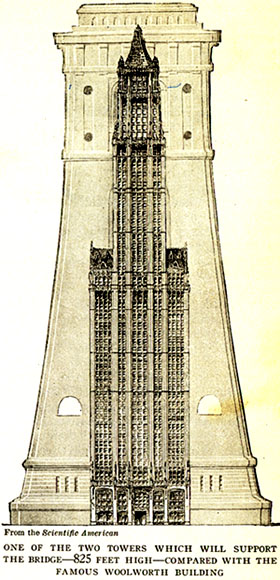
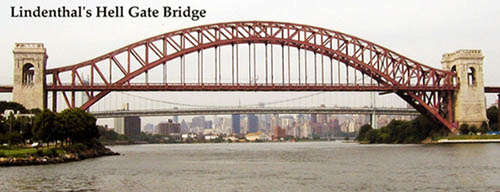
photo by JHL
Click on the thumbnails below to see diagrams of the intended traffic flow through the bridge, and an elevation view comparison of this Lindenthal's bridge with the Brooklyn Bridge:
